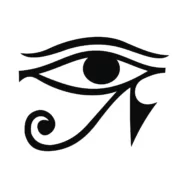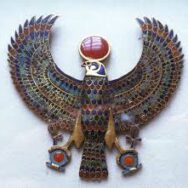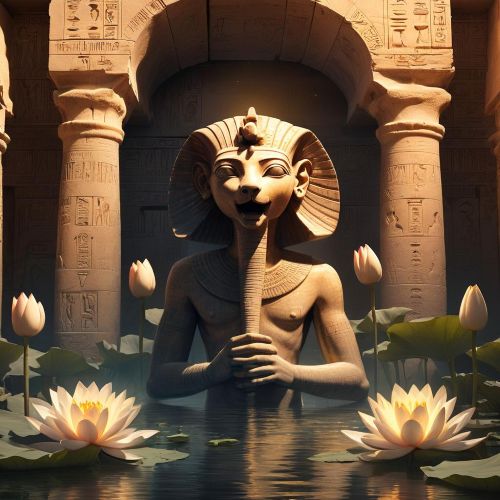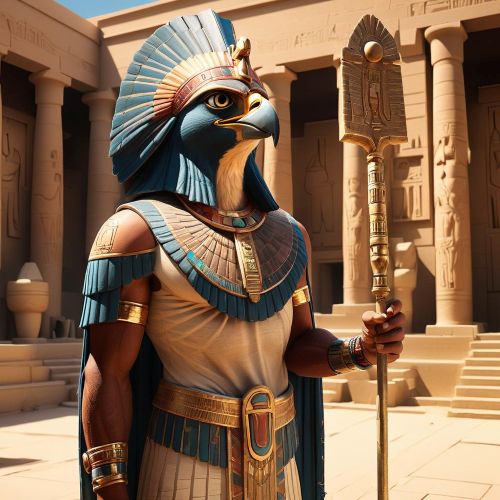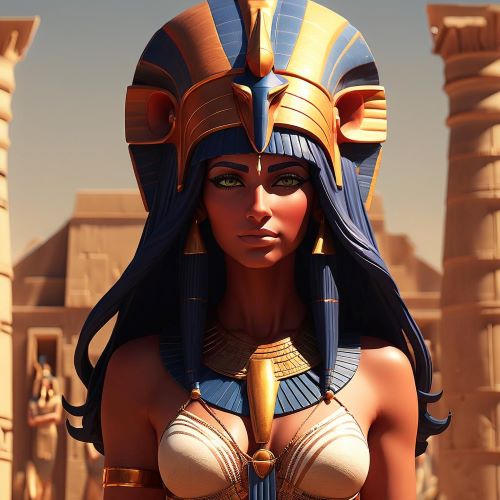Horus : The Sky God
Listen
Horus
Introduction
One of the most prominent deities of ancient Egypt is the god of the skies, Horus. He is often portrayed as either a man with a falcon’s head or a falcon with a double crown, which represents his rule over both Upper and Lower Egypt. The Eye of Horus is a powerful amulet that is connected to his protection and sight.
In ancient Egypt, the gods known as the Egyptian Hor, Har, Her, Heru, or Horus were created as falcon deities. They were represented by the right eye being the sun or morning star, and the left eye being the moon or evening star. During the time of the ancient Egyptian pharaohs, there were numerous falcon cults. The Egyptian god Horus is a complex and contradictory deity. According to the ancient Egyptians, he had many manifestations, and each of them represents a different aspect of his being. He was often depicted as a falcon, and he represented the principles of the kingship of Egypt.
Physical Traits
Horus is one of the most visually striking gods in Egyptian mythology, instantly recognizable by his falcon head and piercing eyes, which symbolize both vision and divine authority. Often shown as a man with the head of a falcon, he wears the Double Crown of Upper and Lower Egypt, a powerful emblem of his rule over the unified kingdom. This crown became one of his most enduring symbols, reflecting his position as a guardian of kingship and a divine legitimizer of pharaohs.
In some depictions, Horus is portrayed as a pure falcon, soaring high above the Nile and the desert. The falcon’s keen eyesight and dominance of the skies made it the perfect animal representation for a god associated with foresight, vigilance, and the sun. His right eye, called the Eye of Ra, was believed to represent the sun, while his left eye, the Eye of Horus, represented the moon. Together, they symbolized balance, order, and cosmic harmony.
Horus is often depicted holding a was-scepter and an ankh, signifying power, authority, and eternal life. His body is typically shown in the idealized proportions of Egyptian art, muscular yet graceful, reflecting both his divine strength and his protective, nurturing qualities as a god of kingship. In temple carvings, Horus is frequently shown towering over enemies, his falcon head crowned with divine regalia, representing not only physical might but also the spiritual dominance of Ma’at, or cosmic order, over chaos.
Family
As the religion grew, it became more apparent that Horus was the son of Isis and Osiris, and he was also the rival of Seth. This resulted in a myth about Seth and Horus, where he was envious of his brother, Osiris. He killed Osiris and split his body into pieces, scattering them throughout Egypt.
With the help of her sister Nephthys, Isis was able to obtain the pieces of her husband, Osiris. After bringing him back to life, Isis became the ruler of the sacred land and the underworld. She also gave birth to Horus, and hid him so that he could one day beat Seth.
When he was older, Horus fought against Seth. After defeating him, he became king. Unfortunately, during the battle, Seth split his eye into six pieces, which caused Thoth to restore his eye and create the Eye of Horus, which is also known as Wadjat. The pieces represent various senses and fractions.
Other names
The name of the god Horus is said to mean “one who is above” or “one who is distant”. His hieroglyph is only shown with one reference to a falcon, and various other names have been given to him, such as the Elder, the Younger, the Edfu, and the Horus in the Horizon, among others. Horus had many forms and manifestations that reflected his different roles and functions. Some of his most common forms include Heru-ur (Horus the Elder): The original form of Horus, who represented cosmic order and primordial kingship. Heru-pa-khered (Horus the Younger): The son of Osiris and Isis, who represented divine kingship and vengeance. Heru-Behdeti (Horus of Behdet): A form of Horus associated with solar power and victory. Her-em-akhet (Horus in the Horizon): A form of Horus associated with resurrection and rebirth.
Powers and Abilities
Horus’s powers extend across the realms of kingship, protection, and divine justice, making him one of the most multifaceted deities in Egyptian religion. As the god of the sky, Horus commanded both the sun and the moon, his eyes embodying these celestial bodies. The rising and setting of the sun were interpreted as Horus’s daily journey across the heavens, guarding the world from the forces of chaos. His ability to control light and darkness gave him dominion over time, sight, and cosmic balance.
One of Horus’s most famous attributes is the Eye of Horus, or Wedjat. This powerful symbol was believed to have healing and protective qualities. According to myth, Horus lost his left eye in his battle against Set, the god of chaos, who had murdered Horus’s father Osiris. The eye was later restored by the god Thoth, transforming it into a talisman of renewal and wholeness. The Eye of Horus became one of the most important amulets in ancient Egypt, used to protect individuals in life and the afterlife, ward off evil, and ensure good health.
Horus also wielded extraordinary martial abilities, befitting his role as a god of war and protection. His battles with Set were legendary, representing the eternal conflict between order and chaos. These confrontations displayed his strength, resilience, and tactical prowess, establishing him as the rightful heir to Osiris’s throne and a symbol of righteous kingship. For the Egyptians, every pharaoh was considered a living embodiment of Horus, inheriting his authority to govern and protect the land.
Beyond warfare, Horus’s powers extended into the spiritual realm. He was seen as a mediator who upheld Ma’at, the divine order of truth, justice, and harmony. His rulership was not only political but also cosmic, ensuring the balance of the universe was maintained. His protective role also made him a patron of families, communities, and travelers, offering safety and guidance through his watchful falcon gaze.
In essence, Horus was not merely a god of the sky but a guardian of civilization itself, embodying courage, protection, and divine legitimacy. His powers united the realms of war, kingship, healing, and cosmic balance, making him one of the most revered and influential gods in the entire Egyptian pantheon.
Modern Day Influence
Christians have been at odds with one another over the interpretation of the story of Jesus as being influenced by the Egyptian deity, Horus, who was the son of Isis and Osiris. This is typically asserted by critics who try to undermine the theological and historical validity of Christianity. Proponents of the idea that Jesus is Horus use a distorted and selective selection of ancient sources, and they do not have the necessary evidence or arguments to support their claims. This is a modern myth that is not supported by any scholarly consensus or proof.
In Assassin’s Creed, one of the Isu, which was an ancient civilization prior to humanity, is Horus. He is the grandfather of Isis and Osiris, and the father of the Younger. He is also featured as a boss in the DLC “The Curse of the Pharaohs.” In Neil Gaiman’s American Gods, the god Horus is mentioned as a deity who came to the US with the immigrants. He is shown as a man with a falcon’s head who can fly and manipulate weather. In Rick Riordan’s The Red Pyramid, one of the gods of Egypt who can be summoned by a magician is Horus. He is shown as a young man with a falcon’s head who can use a khopesh and a sword. He also helps Ra against Apophis.
Related Images
Sources
Allen, J. P. (2014). Middle Egyptian: An introduction to the language and culture of hieroglyphs (3rd ed.). Cambridge University Press.
Britannica. (n.d.). Horus. In Encyclopaedia Britannica. Retrieved September 11, 2025, from https://www.britannica.com/topic/Horus-Egyptian-god
David, R. (2002). Religion and magic in ancient Egypt. Penguin Books.
Hornung, E. (1999). The ancient Egyptian books of the afterlife. Cornell University Press.
Mark, J. J. (2017, February 17). Horus. In J. Cartwright (Ed.), World History Encyclopedia. Retrieved September 11, 2025, from https://www.worldhistory.org/Horus/
Pinch, G. (2002). Egyptian mythology: A guide to the gods, goddesses, and traditions of ancient Egypt. Oxford University Press.
Shaw, I., & Nicholson, P. (2002). The dictionary of ancient Egypt. Harry N. Abrams.
Tyldesley, J. (2000). Myths and legends of ancient Egypt. Penguin Books.
Tour Egypt. (n.d.). Horus, the falcon-headed god. Tour Egypt. Retrieved September 11, 2025, from http://www.touregypt.net/godsofegypt/horus.htm
Frequently Asked Questions
What is Horus the god of?
Horus, the majestic falcon-god of ancient Egypt, soared through the sky as the embodiment of kingship, sun, and war. Protector of pharaohs and healer of mothers, his watchful eyes symbolized sight and restoration, while his epic battle against his uncle revealed his fierce warrior spirit. From vulnerable child to triumphant king, Horus’ tale unfolded as a metaphor for transformation and life’s eternal cycle.
Did Horus fall in love?
Though Egyptian myths lacked Cupid’s arrows, Horus and Hathor shared a fascinating bond. She mothered and supported him, then later became his wife, embodying a union not of passionate hearts, but of divine loyalty, cosmic balance, and restoration after hardship.
What does the Horus symbolize?
From celestial majesty to earthly guardianship, Horus’ symbolism soars. He embodies the sun’s brilliance, the pharaoh’s might, the healer’s touch, and the warrior’s spirit, his journey a testament to growth and cosmic balance, forever etched in the heart of ancient Egypt.
Was Horus born of a virgin?
While Isis’ magical feat of resurrecting Osiris enabled Horus’ birth, it wasn’t a virgin conception in the modern sense. Egyptian mythology, steeped in divine magic and physical interactions, offers a unique perspective on creation, death, and rebirth, one where Horus’ origin unfolds as a captivating tale of resilience and divine ingenuity.
Who was the wife of Horus?
While Horus often dances with Hathor, both mother and wife in a cosmic ballet of balance and loyalty, whispers of other wives, fiery scorpion goddesses guarding his path, emerge from the shadows of lesser-known myths. Ultimately, whether he reigns solo or shares his sky with a consort depends on the story, each painting a different facet of the falcon god’s multifaceted legend.







